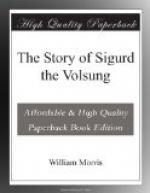BIOGRAPHICAL INTRODUCTION
By J. W. Mackail
William Morris, one of the most eminent imaginative writers of the Victorian age, differs from most other poets and men of letters in two ways—first, he did great work in many other things as well as in literature; secondly, he had beliefs of his own about the meaning and conduct of life, about all that men think and do and make, very different from those of ordinary people, and he carried out these views in his writings as well as in all the other work he did throughout his life.
He was born in 1834. His father, a member of a business firm in the City of London, was a wealthy man and lived in Essex, in a country house with large gardens and fields belonging to it, on the edge of Epping Forest. Until the age of thirteen Morris was at home among a large family of brothers and sisters. He delighted in the country life and especially in the Forest, which is one of the most romantic parts of England, and which he made the scene of many real and imaginary adventures. From fourteen to eighteen he was at school at Marlborough among the Wiltshire downs, in a country full of beauty and history, and close to another of the ancient forests of England, that of Savernake. He proceeded from school to Exeter College, Oxford, where he soon formed a close friendship with a remarkable set of young men of his own age; chief among these, and Morris’s closest friend for the rest of his life, was Edward Burne-Jones, the painter. Study of the works of John Ruskin confirmed them in the admiration which they already felt for the life and art of the Middle Ages. In the summer vacation of 1855 the two friends went to Northern France to see the beautiful towns and splendid churches with which that country had been filled between the eleventh and the fifteenth centuries; and there they made up their minds that they cared for art more than for anything else, such as wealth or ease or the opinion of the world, and that as soon as they left Oxford they would become artists. By art they meant the making of beauty for the adornment and enrichment of human life, and as artists they meant to strive against all that was ugly or mean or untruthful in the life of their own time.
Art, as they understood it, is one single thing covering the whole of life but practised in many special forms that differ one from another. Among these many forms of art there are two of principal importance. One of the two is the art which is concerned with the making and adorning of the houses in which men and women live; that is to say, architecture, with all its attendant arts of decoration, including sculpture, painting, the designing and ornamenting of metal, wood and glass, carpets, paper-hangings, woven, dyed and embroidered cloths of all kinds, and all the furniture which a house may have for use or pleasure. The other is the art which is concerned with the making




